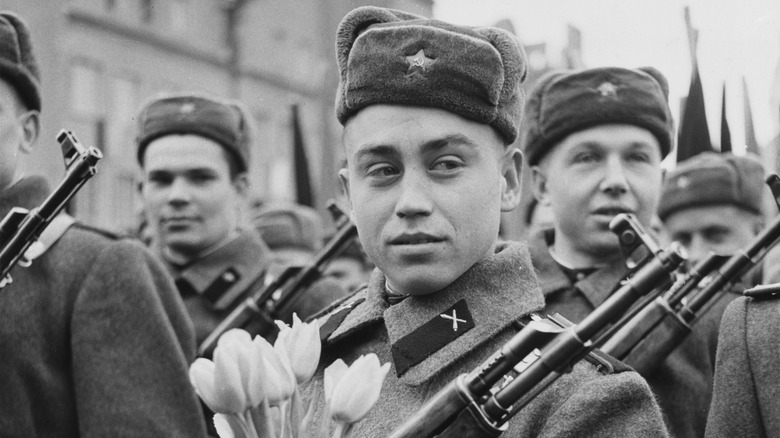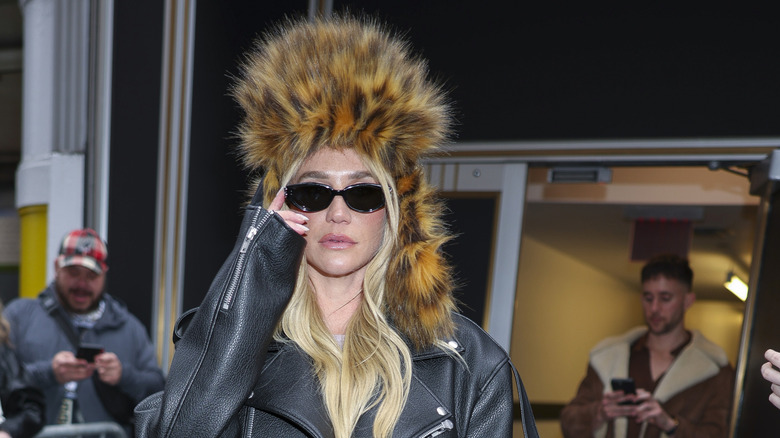Here's What These Iconic Russian Hats Are Called
When it comes to symbols of Russian culture, there are probably a few things that come to mind. Some examples of the country's unofficial symbols are Russian dolls, classical ballet, babushkas, and vodka (the drink even has a dedicated museum, one of the bizarre things that only exist in Russia). Then, of course, there's that iconic hat.
You know the one. Typically made of fur or faux fur, the fuzzy round cap is characterized by the long ear flaps that ornament each side and has become an enduring albeit stereotypical symbol linked to Russian heritage. Perhaps you can recall the legendary Arnold Schwarzenegger rocking one in the 1988 film "Red Heat," or George Costanza comically sporting one in a Season 8 episode of "Seinfeld."
Sure, maybe you can easily conjure up an image of the hat from pop culture, but do you know what it's called? Although sometimes referred to as a "fur hat" or a "trapper hat," its official Russian name — which fittingly translates to "ear hat" — is ushanka. And its history goes back quite a few years.
The history of the ushanka
As you might suspect, ushankas are nothing new. In fact, in one form or another, they've been keeping heads warm for centuries. According to Traclet, an earlier iteration of the ushanka was a similar-looking three-point hat called a "treukah." Dating back to the 16th century, the treukah was commonly worn throughout central and northern Russia, and was distinguished by its signature ear flaps.
Flash-forward to the early 20th century and the modern version of the hat (the ushanka) was popularized during the Russian Civil War when Siberian leader, Aleksandr Kolchak, made them a standard piece of military uniforms in the White Army. Named after Kolchak, the hat was called a kolchakovka at the time, and was vital to keeping soldiers warm during harsh winter battles. After losing men to cold exposure during the Winter War in Finland, the Red Army also adopted the hats as part of their uniform, as did the German soldiers during World War II — a battle that changed the course of history.
Although the hat was retired as an official part of the Russian military uniform in 2013, the modern-day ushanka adorns heads all over the world, worn in various countries including China, Canada, and the colder regions of the United States. They're not just for soldiers anymore, either — they've evolved into a fashion accessory sported by musicians, movie stars, and everyday people.
The evolution of the ushanka
Though there are several variations of the ushanka, the ear flaps are the hat's defining feature. A traditional design has strings attached to them, making it easier to tie under the chin and protect the face from exposure to harsh winter elements. The front side of a typical ushanka is also equipped with an adjustable visor (resembling that of an aviator hat), which can be folded down to shield the eyes. As for their construction, the hats are made with thick, warm materials to ward off the cold. Fur (real or fake) is the distinctive material used in making the hats. Classic ushankas are most commonly made with sheepskin fur, rabbit fur, and even fox fur.
Nowadays, the more fashion-focused ushankas are made from faux fur, offering a cruelty-free alternative while maintaining the traditional look. One such faux fur variation was featured in the Chanel 2013-2014 collection, with other famous fashion lines like Ralph Lauren adding ushanka-inspired hats to their winter collections as well. From battlefields to runways, the ushanka has spanned the centuries as both a functional and fashionable piece of headwear, enduring as one of the most widely-recognized symbols of Russian culture.


